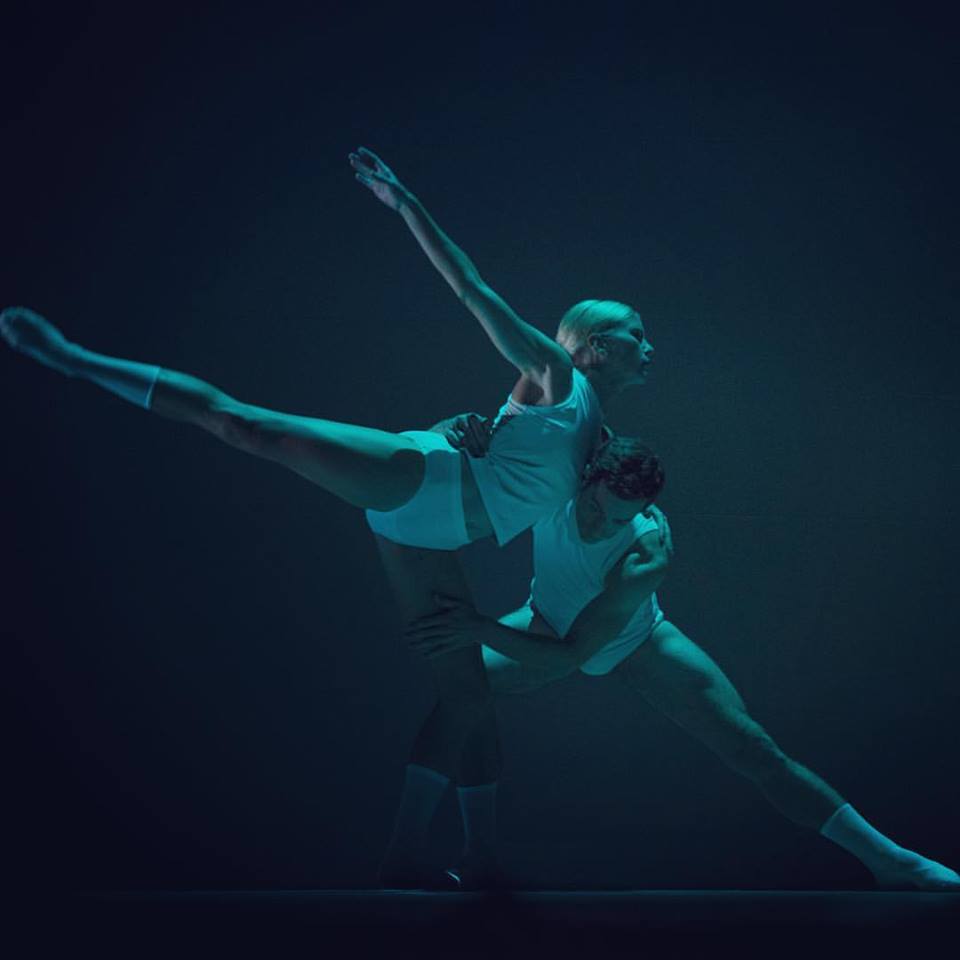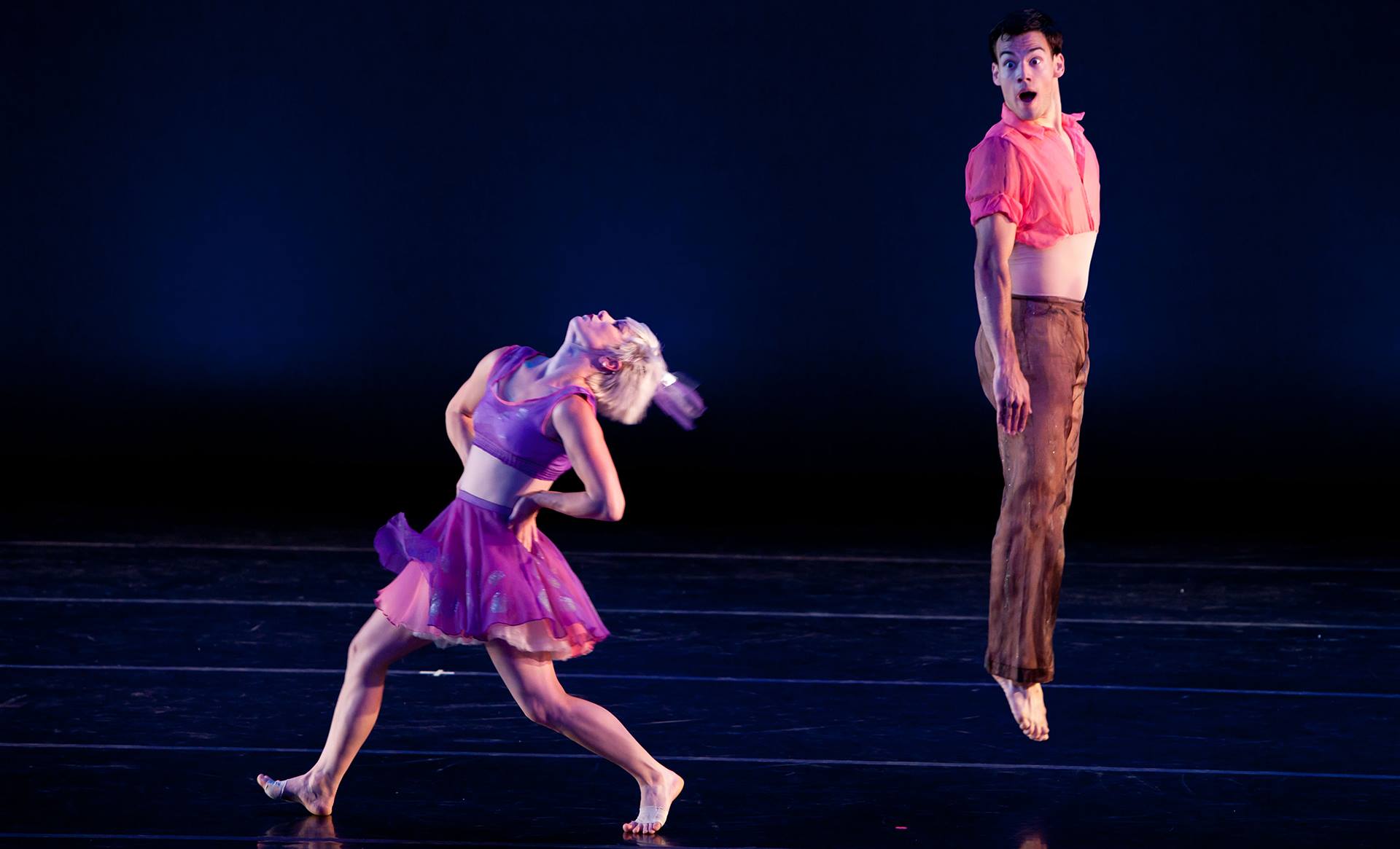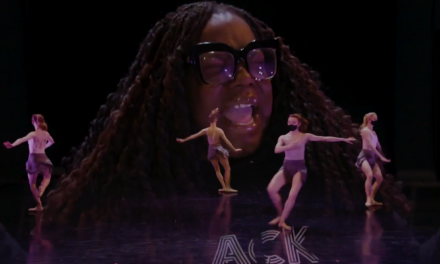Emily Reinking O’Dell performing Robert Curran’s How They Fade. Photo by Sam English
Stars + Stripes
Review by Annette Skaggs
Entire contents are copyright © 2016 Annette Skaggs. All rights reserved.
Upon entering the lobby of the Kentucky Center for the Arts one’s attention was drawn to the pictures and comments from the past 65 years of the Louisville Ballet’s history in the Making Moving Art exhibit. Among the photos are scenes of breathtaking costumes and stunning movements in time. So to begin the historic season we dived into three dances: Balanchine’s choreography set to Tchaikovsky’s Theme and Variations, Robert Curran’s How They Fade, and Twyla Tharp’s setting to Philip Glass’s In the Upper Room.
Yes indeed, Mr. Curran has presented a new World Premiere to the Louisville audience. But more on that later. Let’s delve into the oft performed Theme and Variations from Balanchine.
With beautiful and resonant notes from an age when the world’s eyes were set upon the Russian ballet stages, it is clear to see how this piece has stood the test of time. Lit with autumnal hues lovely ballerinas emerge decked out in gold brocade tutus, with male counterparts in equally shining suits. Performing to Tchaikovsky’s piece by the same name, pirouettes and pas de deux’s fill the stage with shimmering grace.
I did notice that the male lead, Mark Krieger, seemed to struggle a little bit through the routine. Most noticeably when he was in a free spin and seemed to either get dizzy and/or lose his footing. It was unusual for him and very well could have been a fluke, but it didn’t change the tone of the piece too much. The female lead Natalia Ashikhmina seemed to be off by half a beat on occasion too, but again, not a big deal.
Perhaps the most interesting part of the piece comes toward the end where you have 26 people on stage performing a perfect polonaise that looks effortless, smiles on each face enjoying the dance. The fact that you have that many people crossing and dancing with each other takes great skill and attention.
Twyla Tharp’s In the Upper Room, is set to music by Philip Glass. If you know anything about Philip Glass, you know that his music can be, in a word, unusual. Leave it to Ms. Tharp to be able to choreograph to Mr. Glass’s musical ways. Having first premiered in the mid ‘80s, it is not hard to see within the setting of the 9 scenes that Ms. Tharp was influenced by aerobics and Jazzercise. These moves were commonly strewn throughout the performance. And being the versatile performer that Ms. Tharp is, it was not uncommon for her to incorporate other dance genres as well. Samba. Tango. Chorus Line. Yes, these and others were scattered over the set. As commonplace as these styles may seem to be, some of the more complicated maneuvers were unique. One that comes to mind is the transference of a ballerina, poised on a dancer and then seamlessly transferred to another dancer, without a hitch.
With Norma Kamali’s nifty striped costumes adorned by red highlights and the clever use of fog and lights, the audience is sometimes slow to notice that there is almost always someone on stage. Perpetual motion. Because of this I noticed that toward the end of the evening it looked as though our well trained and lovely ballet troupe was starting to run out of gas, there were problems with synching and signs of fatigue began to show. Philip Glass is famous for holding his audience through repetition, but when Ms. Tharp’s choreography echoed that quality, it seems inconsistent with her reputation for idiosyncratic ingenuity.
Before the curtain raised, Mayor Greg Fischer, who lauded the Ballet on their 65th Anniversary, crediting them for, “stirring the soul of the city”, joined Robert Curran and Louisville Ballet Board President Lisa Leet on stage. I am assured that will continue to happen after seeing Robert Curran’s World Premiere How They Fade.
The stage is set with what appears to be an open box, designed by local artist Letitia Quesenberry and with soft lighting by Trad Burns. In the pit a lovely sound emerges from the Louisville Orchestra, who is joined by the San Francisco rock group YASSOU. With a heavy synthesizer and string sound emanating throughout Whitney Hall, dancer Brandon Ragland, clad in a simple white shirt, shorts and socks, encircles the perimeter of the box: registering little moves here and there. Then come more dancers and more. Then suddenly, from within the troupe lead singer Lilie Bytheway-Hoy emerges and begins to sing. Her upper-register voice gave a haunting quality to the piece, despite her lyrics being unintelligible.
The maneuvers and movements that I was witness to that evening were unlike anything I had ever experienced from the Louisville Ballet. Peak physicality was essential as both men and women were used as leverage in bending, twisting and/or contorting themselves into varying human sculptures. All of it was deliciously sensual, if not harboring a little sexual sublimation.
Toward the end of the piece a gauzy scrim descended from the top and projected thereupon was a grainy looped video of the lead singer. Now, I like the idea of adding video production if it doesn’t distract from the talent on stage. Unfortunately, for this piece, it did, because not only was there the one scrim, there would be the rise and fall of two more, along with an ever increasing volume of sound coming from the pit. Because of these things, it was hard to keep my attention on the dancing.
Still and all, I have to say that How They Fade was perhaps one of the most powerful performances that I have seen from the Louisville Ballet.
Bravi, Tutti!
Stars + Stripes
September 9 & 10, 2016
Louisville Ballet
Whitney Hall, The Kentucky Center for the Arts
501 W Main St
Louisville, KY 40202
louisvilleorchestra.org
Annette Skaggs is heavily involved as an Arts Advocate here in Louisville. She is a freelance professional opera singer who has performed throughout Europe and in St. Louis, Cincinnati, Boulder, Little Rock, Peoria, Chicago, New York and of course Louisville. Aside from her singing career, she has been a production assistant for Kentucky Opera, New York City Opera, and Northwestern University. Her knowledge and expertise have developed over the course of 25+ years’ experience in the classical arts.





